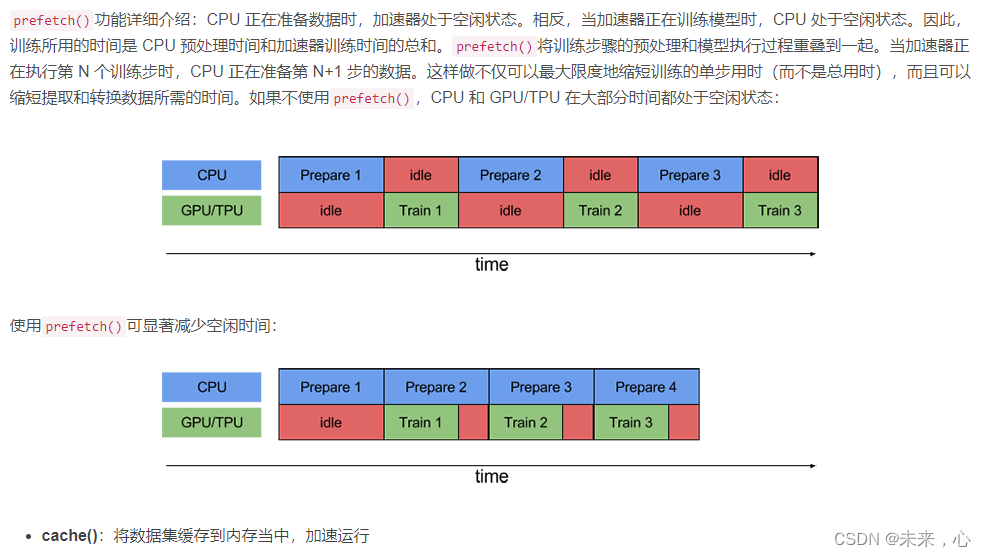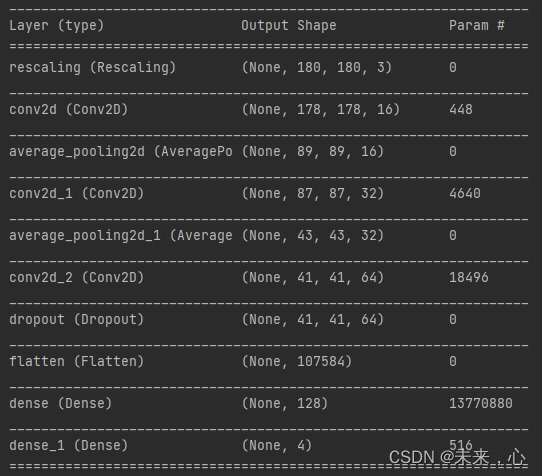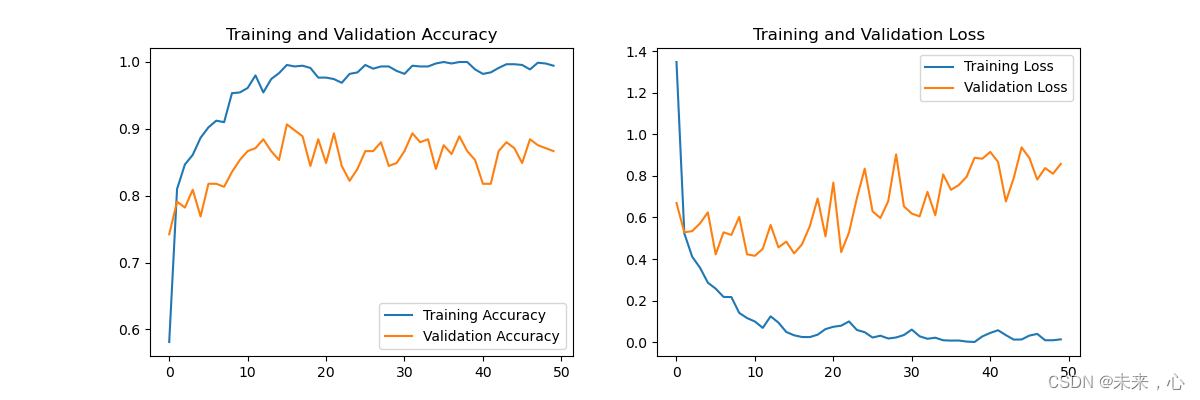通过图像识别的学习,初步总结了图像识别的流程及归类,希望可以帮到正在学习的小伙伴。

一、前期准备工作
1、数据集的获取
在进行数据分析之前需要有数据进行识别,这里所谓的数据指的是图像,我们需要对需要识别的图像分好其类别才能更好的调用。下面以天气数据集为例,共分为四类,数据集划分如下图所示:
['cloudy', 'rain', 'shine', 'sunrise']

2、获取数据集路径
获取数据集的方法有很多,这里使用的是pathlib函数库,也可以使用os函数库获取数据
import pathlib
data_dir = "G:\BaiduNetdiskDownload\climate\weather_photos/"
data_dir = pathlib.Path(data_dir)
#查看数据数量
image_count = len(list(data_dir.glob('*/*.jpg')))
3、数据集划分
这里函数validation_split将数据集划分为0.8:0.2即4:1
#训练集
train_ds = tf.keras.preprocessing.image_dataset_from_directory(
data_dir,
validation_split=0.2,
subset="training",
seed=123,
image_size=(img_height, img_width),
batch_size=batch_size)
#验证集
val_ds = tf.keras.preprocessing.image_dataset_from_directory(
data_dir,
validation_split=0.2,
subset="validation",
seed=123,
image_size=(img_height, img_width),
batch_size=batch_size)
4、数据预处理
shuffle():打乱数据,关于此函数的详细介绍可以参考: https:lzhuanlan.zhihu.com/p/42417456
prefetch():预取数据,加速运行

AUTOTUNE = tf.data.AUTOTUNE
train_ds = train_ds.cache().shuffle(1000).prefetch(buffer_size=AUTOTUNE)
val_ds = val_ds.cache().prefetch(buffer_size=AUTOTUNE)
num_classes = 4
batch_size = 32
img_height = 180
img_width = 180
二、网络模型构建
1、模型搭建
卷积神经网络的基本组成包括输入层、卷积层、激活函数、池化层、全连接层(放在最后作为输出层)等组成。各层的主要功能这里不在详细介绍,可以参考连接
直接上代码:
model = models.Sequential([
layers.experimental.preprocessing.Rescaling(1. / 255, input_shape=(img_height, img_width, 3)),
layers.Conv2D(16, (3, 3), activation='relu', input_shape=(img_height, img_width, 3)), # 卷积层1,卷积核3*3
layers.AveragePooling2D((2, 2)), # 池化层1,2*2采样
layers.Conv2D(32, (3, 3), activation='relu'), # 卷积层2,卷积核3*3
layers.AveragePooling2D((2, 2)), # 池化层2,2*2采样
layers.Conv2D(64, (3, 3), activation='relu'), # 卷积层3,卷积核3*3
layers.Dropout(0.3),
layers.Flatten(), # Flatten层,连接卷积层与全连接层
layers.Dense(128, activation='relu'), # 全连接层,特征进一步提取
layers.Dense(num_classes) # 输出层,输出预期结果
])
model.summary() # 打印网络结构
其网络详细参数可通过**model.summary()**打印出

2、网络配置
包括优化器的选取、算是函数的选取、学习率的设计
# 编译 设置优化器
#learning_rate=0.001学习率
opt = tf.keras.optimizers.Adam(learning_rate=0.001)
model.compile(optimizer=opt,
loss=tf.keras.losses.SparseCategoricalCrossentropy(from_logits=True),
metrics=['accuracy'])
三、模型评价
1、训练+验证
epochs = 50#训练次数
history = model.fit(
train_ds,
validation_data=val_ds,
epochs=epochs
)
训练过程可视化代码
acc = history.history['accuracy']
val_acc = history.history['val_accuracy']
loss = history.history['loss']
val_loss = history.history['val_loss']
epochs_range = range(epochs)
plt.figure(figsize=(12, 4))
plt.subplot(1, 2, 1)
plt.plot(epochs_range, acc, label='Training Accuracy')
plt.plot(epochs_range, val_acc, label='Validation Accuracy')
plt.legend(loc='lower right')
plt.title('Training and Validation Accuracy')
plt.subplot(1, 2, 2)
plt.plot(epochs_range, loss, label='Training Loss')
plt.plot(epochs_range, val_loss, label='Validation Loss')
plt.legend(loc='upper right')
plt.title('Training and Validation Loss')
plt.show()
训练过程如下图

2、评价
将训练的模型进行保存,用于评价预测结果时调用
model.save('./checkpoint/model.h5')
#评价结果
score = model.evaluate_generator(Generator(testpath,batch_size),steps=int(m) // batch_size)
评价公式如下
def Precision(y_true, y_pred):
"""精确率"""
tp = K.sum(K.round(K.clip(y_true * y_pred, 0, 1))) # true positives
pp = K.sum(K.round(K.clip(y_pred, 0, 1))) # predicted positives
precision = tp / (pp + K.epsilon())
return precision
def Recall(y_true, y_pred):
"""召回率"""
tp = K.sum(K.round(K.clip(y_true * y_pred, 0, 1))) # true positives
pp = K.sum(K.round(K.clip(y_true, 0, 1))) # possible positives
recall = tp / (pp + K.epsilon())
return recall
def F1(y_true, y_pred):
"""F1-score"""
precision = Precision(y_true, y_pred)
recall = Recall(y_true, y_pred)
f1 = 2 * ((precision * recall) / (precision + recall + K.epsilon()))
return f1
如何使用,请参考链接





















 2121
2121











 被折叠的 条评论
为什么被折叠?
被折叠的 条评论
为什么被折叠?








